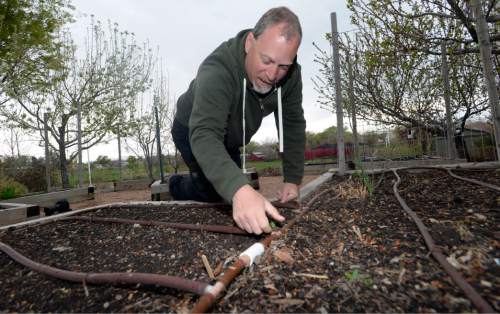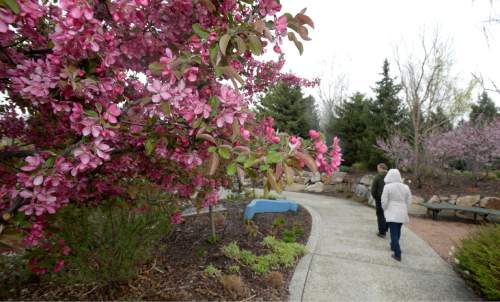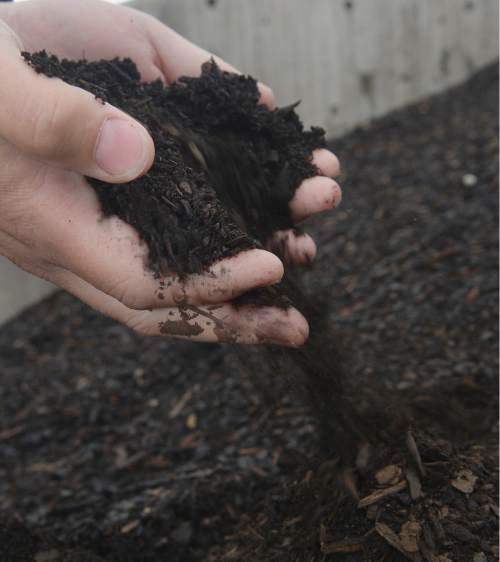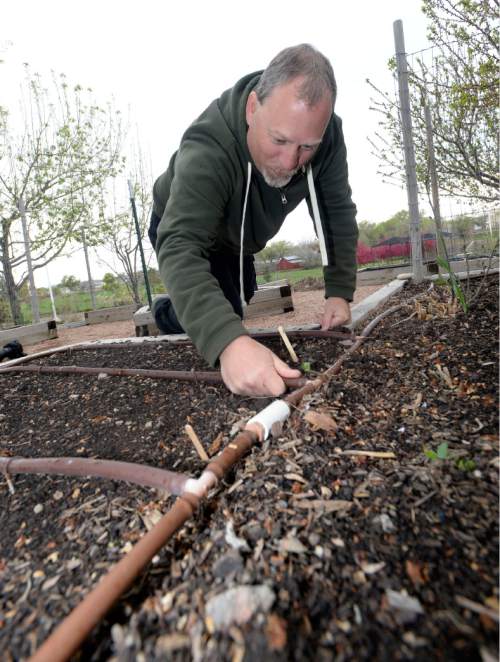This is an archived article that was published on sltrib.com in 2016, and information in the article may be outdated. It is provided only for personal research purposes and may not be reprinted.
In Utah, the second driest state in the nation, it's possible to grow a successful vegetable garden and avoid being called a water hog.
From installing more efficient irrigation systems to applying mulch or even just watering at the right time of day, it's possible to garden with less H2O, said Katie Wagner, a member of Utah State University Extension's horticulture faculty.
"Sometimes we think plants need more water than they really do," said Wagner, one of several Salt Lake City experts we contacted in advance of Earth Day on Friday, April 22. They offered these seven tips to grow a vegetable garden with less water.
Know your soil
There's no substitute for a healthy soil, as it plays a major role in how you will water and how your plants grow, said Wagner. "If the soil texture is sandy, you probably will need to water more frequently, but with less water. If it has more clay, you can water less often, but when you do it needs to be a nice deep watering."
Not sure what type of soil you have? Gardeners can send soil samples to USU's Analytical Labs for a routine test. The results will be returned with information about soil type and levels of salinity, pH, phosphorus and potassium. This baseline information can help gardeners know what kind of nutrients to add to create a healthy soil, which in turn holds water more efficiently. Forms and instructions can be found at http://www.usual.usu.edu . A routine test costs $23.
Water efficiently
The overhead sprinkling system may work fine for the lawn, but it's not the most efficient way to apply water in the garden because much of the water evaporates before it hits the soil, or the water lands on leaves and never makes it to the roots where it's needed. An in-line drip irrigation system, which is positioned on the ground, gets the water directly to the roots, said Wagner. There's an added bonus to using a soaker hose system: It cuts down on weeds.
While gardens typically need to be watered every two to three days, just looking at the soil isn't a good way to tell when to turn on the hose, said Wagner. "It may look dry on top, but the soil underneath may still be moist." Buying a commercial moisture meter is one option, but digging into the dirt a few inches with your fingers works just as well, Wagner said. "Explore a little bit more and don't just assume it's time to water."
Water early in the day
When the garden is truly thirsty, give it a drink early in the morning when the temperatures are lower and evaporation is minimal. It also makes the water available to the plants throughout the day so they are better able to deal with the heat. Watering later in the day will work, as long as the leaves have time to dry before night, said Wagner. Damp leaves at night can cause mildew and mold to grow, which can negatively affect plants.
Add mulch
Adding 1 to 2 inches of mulch around your vegetable plants can reduce evaporation and the need for water. Mulch also helps keep weeds at bay.
Many things will work as a natural mulch: grass clippings, dried leaves, straw and shredded bark. But for home gardeners, Mike Lorenc, lead horticulturist at the Conservation Garden Park in West Jordan, suggests a trip to a local landfill, many of which offer rich, dark compost at a reasonable price.
Companion plants
Plant fruits and vegetables that grow well together in the same small plot of soil, says Ashley Patterson, executive director of Wasatch Community Gardens. The method, called companion planting, has been around for more than 2,000 years, "long before irrigation systems," she said.
The most popular companion trio is the three sisters: corn, beans and squash. Tall cornstalks provide a structural support for the climbing beans, the beans return nitrogen back into the soil, and the squash spreads across the soil, acting as a mulch and keeping the soil cool. Other good garden companions include basil and tomatoes; and strawberries with onions, spinach and thyme.
Avoid water hogs
Purchase fruit and vegetable varieties that can withstand our hot and dry climate and have proven themselves in Utah soils. Locally owned nurseries are a good place to find the right seeds or seedlings. So are the plant sales sponsored by nonprofits such as Wasatch Community Gardens and Red Butte Garden. This year, the sales take place on May 7. (The Red Butte sale also will run May 6 for garden members.)
Understand the container conundrum
Containers are a great way to grow vegetables in a small space, but they usually require frequent watering. That is especially true with terra-cotta pots, said Patterson. The porous nature of this earth-based medium causes the soil to dry out quickly. For water-wise container gardening, opt for glazed or other nonporous pots.
Water-wise gardening classes
Soil testing and amendments • Learn what it takes to build the best garden soil. Instruction includes how to apply organic matter and soil amendments as well as how to take a soil sample and send it to the analysis lab.
When • April 23, 10 a.m. to noon. Class repeated April 30, 2-4 p.m.
Where • Grateful Tomato Garden, 800 S. 600 East, Salt Lake City
Cost • $10 per person; scholarships available
Register • wasatchgardens.org
Container Gardening
What • Learn how to design, create and maintain water-wise garden containers.
When • Saturday, May 7, 9 a.m.
Where • Conservation Garden Park, 8275 S. 1300 West, West Jordan
Cost • $5; free for those who take a complimentary survey
Register • ConservationGardenPark.org/Events
Gardening in the Wasatch
What • Learn the best soil amendments, watering strategies and plant selection for gardening along the Wasatch Front. Sponsored by University of Utah Lifelong Learning.
When • Tuesdays from May 10-24, 6 p.m.
Where • Red Butte Garden, 300 Wakara Way, Salt Lake City
Tuition • $69
Register • continue.utah.edu/lifelong











